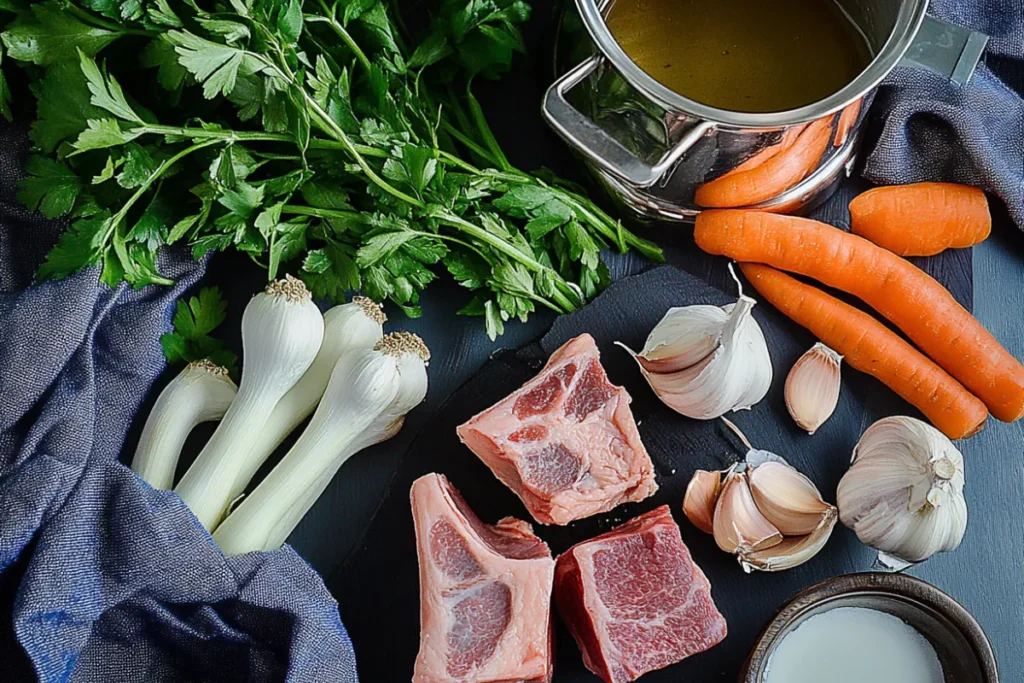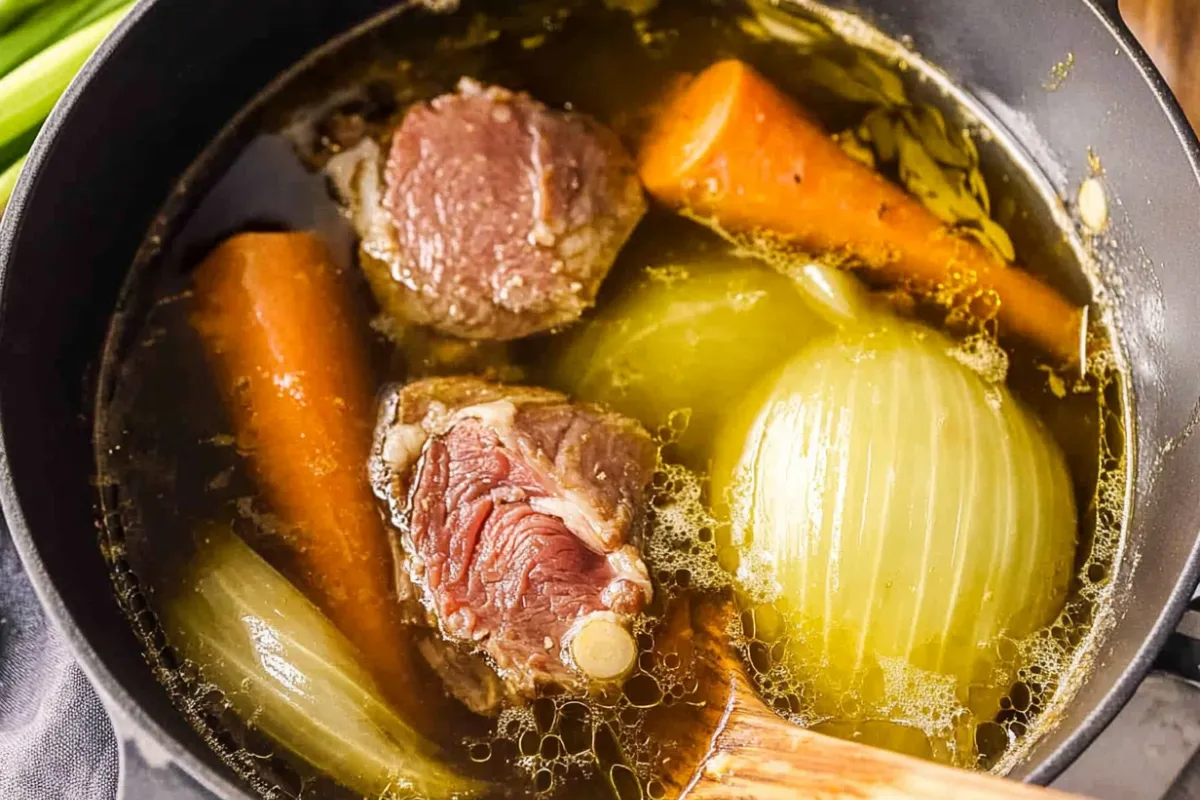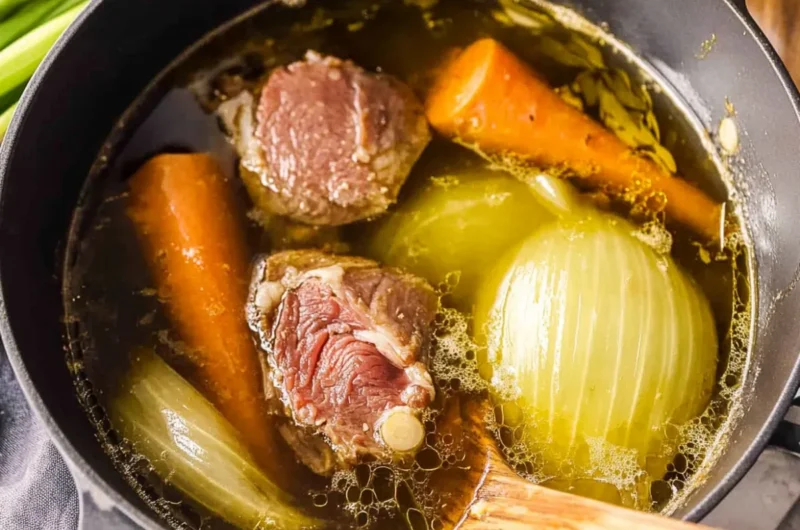Last Updated on February 14, 2025 by Simon
Have you ever wondered what separates a good dish from an extraordinary one? Often, the secret lies in the foundation: a perfectly made meat stock recipe. This culinary gem isn’t just a kitchen staple; it’s the backbone of countless recipes, from soul-soothing soups to elegant sauces. Learning how to make a proper meat stock can elevate your cooking game and add a depth of flavor that store-bought broths can only dream of achieving.
Making meat stock from scratch isn’t as intimidating as it sounds. With just a few simple ingredients and some patience, you can create a liquid gold that’s brimming with nutrients and flavor. Whether you’re a home cook preparing meals for your family or an aspiring chef looking to master the basics, this recipe is the perfect place to start.
Meat stock is incredibly versatile, fitting effortlessly into quick weeknight meals or more elaborate weekend culinary adventures. Its rich, savory aroma and full-bodied taste will have your guests asking, “What’s your secret?” Plus, it’s an excellent way to minimize food waste by making use of bones, vegetables, and herbs that might otherwise be discarded.
Once you’ve tried homemade meat stock, you’ll never look back. Not only will it enhance your dishes, but it’s also a cost-effective and sustainable choice. Stick around as I walk you through this foolproof recipe, complete with pro tips, serving suggestions, and creative uses to help you make the most of your new favorite ingredient.
Table of contents
Why The Meat Stock Recipe Works
1. Deep, Layered Flavors
The key to a standout meat stock is the depth of flavor, achieved by roasting bones before simmering them. Roasting brings out the natural caramelization in the bones, adding complexity to your stock. Combined with a slow simmer and aromatic vegetables, this recipe guarantees a flavor-packed base that enhances any dish.
2. Nutritional Benefits
Homemade meat stock is a powerhouse of nutrients. Rich in collagen, amino acids, and minerals, it’s great for gut health, joint support, and glowing skin. By simmering bones for an extended period, you extract all the goodness into a nutrient-rich liquid that’s both delicious and beneficial for your body.
3. Customizable to Your Preferences
This recipe is highly adaptable. Whether you’re making beef stock, chicken stock, or a mix of the two, the process remains the same. You can also adjust the flavors by adding your favorite herbs, spices, or vegetables. Trying to reduce sodium? You’re in control of the seasoning. Need a stock that’s vegetarian-friendly? Swap the meat for hearty mushrooms and additional veggies.
4. Waste Reduction
One of the most satisfying aspects of making meat stock is how eco-friendly it is. Leftover bones from roasted chicken or beef, vegetable scraps like onion skins and carrot peels, and even herb stems can all find new life in your stockpot. It’s a sustainable way to use ingredients that would otherwise go to waste.
5. Freezer-Friendly
Homemade meat stock freezes beautifully, making it a convenient option for busy days. You can freeze it in ice cube trays for easy portioning or store it in larger containers for soups and stews. With a batch of stock on hand, you’ll always have the foundation for a delicious meal.
Ingredients Breakdown of Meat Stock Recipe
For the Meat Stock
- 2–3 lbs of meat bones (beef, chicken, or a combination):
These are the foundation of your stock. Use marrow bones, knuckle bones, or leftover roasted chicken carcasses for optimal flavor and collagen. - 1 large onion, quartered:
Adds sweetness and depth to the stock. Keep the skin on for a golden hue. - 2–3 carrots, roughly chopped:
A natural sweetener that balances the savory notes. - 2 celery stalks, roughly chopped:
Enhances the herbal and earthy flavors. - 2–3 garlic cloves, smashed:
Adds a subtle aromatic boost without overpowering the stock. - 1–2 bay leaves:
Brings a gentle herbal note that ties the flavors together. - 5–6 sprigs of fresh parsley:
A classic addition for brightness and a fresh finish. - 1 tsp black peppercorns:
Adds a touch of warmth and complexity. - 1 tbsp apple cider vinegar:
Helps extract minerals and collagen from the bones, giving your stock a nutrient-rich base. - Cold water, enough to cover all ingredients:
Ensures a clear and clean stock. Always start with cold water to allow gradual flavor extraction.
Optional Ingredients for Extra Depth
- Tomato paste (1–2 tbsp):
Adds umami and a hint of acidity. Perfect for beef-based stocks. - Mushrooms or mushroom stems:
Great for adding earthy undertones, especially if you’re aiming for a richer flavor. - Leeks (1 chopped):
An alternative to onions for a slightly milder flavor.

Step-by-Step Instructions of Meat Stock Recipe
Step 1: Roast the Bones
Time: 30–45 minutes
- Preheat your oven to 400°F (200°C).
- Spread the bones in a single layer on a baking sheet. For beef stock, consider brushing the bones lightly with tomato paste for added richness.
- Roast the bones for 30–45 minutes, flipping them halfway through, until they’re deeply browned. This step caramelizes the bones and boosts the flavor of your stock.
Tip: Don’t skip this step—it’s what sets an exceptional stock apart from an ordinary one!
Step 2: Prep the Vegetables
Time: 5–10 minutes
- While the bones roast, wash and roughly chop your vegetables. There’s no need to peel them unless desired.
- Smash the garlic cloves to release their oils for a more robust flavor.
Step 3: Simmer the Stock
Time: 4–12 hours
- In a large stockpot, combine the roasted bones, vegetables, garlic, bay leaves, parsley, and peppercorns.
- Add cold water to cover all ingredients by about 2 inches.
- Stir in the apple cider vinegar and let the mixture sit for 20 minutes before heating. This step helps draw out nutrients from the bones.
- Bring the pot to a gentle boil over medium heat, then immediately reduce to a low simmer. Skim off any foam or impurities that rise to the surface in the first hour.
Tip: Avoid letting the stock boil aggressively, as this can make it cloudy.
Step 4: Strain the Stock
Time: 10–15 minutes
- After simmering, remove the pot from heat and allow it to cool slightly.
- Strain the stock through a fine-mesh sieve or cheesecloth into a large container. Discard the solids.
- For a clearer stock, strain it a second time.
Step 5: Cool and Store
Time: Varies
- Let the stock cool to room temperature, then refrigerate. The fat will rise to the top and solidify, making it easy to skim off before use.
- Store in airtight containers or freeze for longer storage.
Pro Tips for Success of Meat Stock Recipe
- Choose Quality Bones:
Opt for bones with plenty of connective tissue, like knuckles, or marrow for the best results. Grass-fed or organic bones are ideal for maximum flavor and nutrition. - Layer the Flavor:
Roast your bones and vegetables for a richer, more complex taste. If you skip this step, the stock may lack depth. - Keep It Gentle:
A slow simmer is key. Avoid boiling the stock, as it can emulsify the fats and make the stock greasy or cloudy. - Add Vinegar:
This small step makes a big difference. Vinegar helps extract collagen and minerals from the bones, creating a more gelatinous and nutrient-packed stock. - Don’t Overdo the Salt:
It’s best to keep the stock lightly seasoned or unsalted. You can always adjust the salt level when you use it in a recipe. - Time is Your Friend:
The longer you simmer the stock, the more flavorful and nutrient-rich it will become. Aim for at least 4 hours, but overnight is even better. - Save Your Scraps:
Keep a bag of vegetable peels, herb stems, and leftover bones in your freezer. When you’re ready to make stock, you’ll have all the ingredients handy. - Freeze in Portions:
Freeze stock in ice cube trays or silicone molds for convenient, single-serving portions. These are perfect for quick sauces or small-batch recipes.
Variants of the Meat Stock Recipe
- Beef Stock:
Use marrow and knuckle bones from beef or veal. Add tomato paste while roasting the bones for a richer color and umami flavor. This variant is perfect for hearty soups like French onion or as a base for beef stews. - Chicken Stock:
Utilize a whole chicken, chicken carcass, or a mix of wings, thighs, and drumsticks. Add rosemary, thyme, and lemon for a light and aromatic stock. Ideal for chicken noodle soup or risottos. - Vegetable-Enriched Meat Stock:
Include vegetables like leeks, parsnips, or fennel to add sweetness and complexity. This works beautifully as a versatile stock for soups or sauces where a lighter flavor is desired. - Bone Broth:
Simmer bones for 12–24 hours, allowing maximum collagen extraction. Add ginger and turmeric for anti-inflammatory properties. Great as a nutrient-rich beverage or in recipes requiring extra depth. - Seafood Stock:
Swap meat bones for shrimp shells, fish heads, or crab shells. Add white wine and parsley for a bright, briny flavor. Use this as a base for paella or bouillabaisse.
Serving Suggestions
Meat stock is incredibly versatile, acting as the foundation for numerous dishes. Here are some ways to elevate your meals with this homemade delight:
1. Soups and Stews
- Use it as the base for classic soups like chicken noodle, beef barley, or minestrone.
- For stews, combine it with chunks of meat, root vegetables, and a splash of wine for a comforting dish.
2. Sauces and Gravies
- Reduce meat stock to create a rich, concentrated sauce for steaks or roasts.
- Whisk it into a roux for velvety gravy.
3. Risottos and Grain Dishes
- Replace water with stock when cooking risotto, quinoa, or rice for added depth and richness.
4. Braising Liquid
- Use it to braise meats or vegetables, infusing them with flavor during the cooking process.
5. Sipping Broth
- Warm a cup of meat stock, season it with salt and pepper, and enjoy it as a soothing drink.
Garnishes and Additions
- Top your soups with freshly chopped herbs, a squeeze of lemon, or a dollop of sour cream for added freshness.
- For Asian dishes, add sliced green onions, sesame oil, or chili flakes to complement the stock’s flavors.
Recipe Card
FAQs or Troubleshooting Meat Stock Recipe
This could be due to under-seasoning or not using enough bones and vegetables. Roasting the bones enhances the flavor, so don’t skip that step!
Avoid boiling the stock too vigorously and skim off foam and impurities as it simmers. Use a fine-mesh sieve or cheesecloth for straining.
Absolutely! Just thaw them beforehand and follow the same roasting process to maximize flavor.
Add collagen-rich bones like chicken feet or beef knuckles. A splash of apple cider vinegar helps extract collagen.
No, leaving the skins on adds color and nutrients. Just wash them thoroughly before use.
Final Thoughts
If you’ve never made homemade meat stock before, now is the time to give it a try. This recipe is easy, economical, and versatile—plus, it delivers unbeatable flavor and nutrition. Once you taste the difference in your dishes, you’ll never want to go back to store-bought options.
Feel free to experiment with the recipe and make it your own. Don’t forget to share your thoughts in the comments or on social media. If you loved this recipe, you might also enjoy exploring other homemade staples like this busy day soup recipe.
Next up: Check out our Sassy Rice Recipe, which pairs beautifully with this meat stock!


